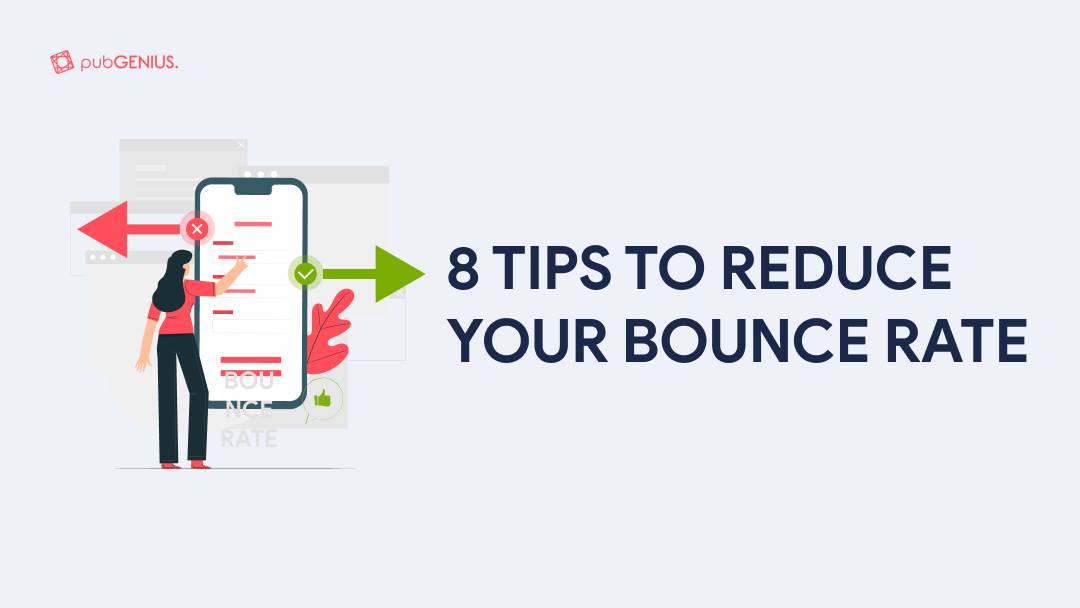Reducing High Bounce Rate - 8 Pro Tips for Better Engagement and Conversions
November 11, 2021
High user bounce rate is one of the most frequent, fundamental and considerable issues that web publishers are facing. Whether your goal is to convert website visitors into paying customers or just content subscribers, if users are abandoning your website soon after opening the main page without any interactions, it is definitely a problem. High bounce rate prevents you from capitalizing the traffic your website is getting online. It undermines all the other efforts aimed at improving user experience and increasing the audience.
Today let’s take a closer look at this issue. We provide you with a number of proven ways to reduce the bounce rate.
What is bounce rate?

But first, let’s make sure we are on the same page about what bounce rate actually is.
Google defines bounce rate as “single-page sessions divided by all sessions, or the percentage of all sessions on your site in which users viewed only a single page and triggered only a single request to the Google Analytics server.” In other words, bounce rate is a percentage of visitors who leave your website soon after entering it and without visiting other pages or performing any kind of activity on it.
High bounce rate is a clear indicator that you have problems with your landing page or the website in general. It can be a confusing design, annoying ads, high latency or some other reason.
What bounce rate is considered to be bad?
If you are wondering what bounce rate is considered to be high, the answer is not that simple. It really depends on what kind of website it is, its purposes and the content. So what some websites view as catastrophically bad bounce rate may be acceptable or even good for others.
But the general perception of the bounce rate metrics is the following:
- 80% bounce rate or higher is considered to be very bad. It can still be acceptable for certain kinds of websites, if they are getting high amounts of untargeted traffic. (large websites with entertaining content, for example).
- Bounce rate between 70 and 80% is still pretty bad.
- 50-70% bounce rate is considered to be average, but can still be bad depending on the traffic source.
- 30-50% is usually viewed as a good bounce rate.
- 20% or less is an excellent bounce rate, which is typically very difficult to achieve. It can also just be a result of inaccurate website usage tracking.
How to reduce bounce rate? 8 tips
Being one of the most crucial indicators of user engagement, bounce rate is a way to spot problems. If your bounce rate is high, it is a clear sign that some changes need to be made, whether it’s redesigning the website, changing marketing strategy or something else.
Reducing bounce rate is a straightforward way to increase the conversion of new visitors to customers/subscribers.

As we mentioned earlier, there can be dozens of specific reasons why your bounce rate is high. This leads to just as many different potential solutions to this problem. So if you are facing this issue, it makes sense to start from reviewing your website.
Here are several specific recommendations and strategies.
-
Check your website’s design.
It makes a lot of sense to start by analyzing your website’s design and what may be wrong with it. There are various elements of website design that can make people leave the page, contributing to high bounce rates. Obviously, your goal is to improve the user experience by creating clean and well-structured web pages with a friendly interface.
-
Improve content formatting and readability.
Poor formatting and low readability is one of the most common reasons for website users to bounce. People tend to feel intimidated by large chunks of text and often give up without giving your content a chance. This is why it is so important to structure your content properly, dividing it into sections and paragraphs, using subtitles and bullet points, etc.
-
Reduce latency and minimize page load time.
Latency is the time it takes for a data packet to move across a network connection. When the latency occurs, it results in a visible delay between the request and the time when content and/or ad is actually displayed. Slow page load speed (latency) is another very common problem that can easily be a major contributor to high bounce rate.
We were talking about the importance of dealing with programmatic ads-related latency multiple times previously in our blog. Read our article on the most common ad stack problems and the one comparing client-side and server-side header bidding solutions to learn more about latency and how to deal with it. But using RTB platforms is not the only reason your website may have a slow loading speed. There are multiple factors that can contribute to latency, including the hosting you use, the volume of traffic, types of content displayed on it and web technologies implemented in it.
The majority of users expect a website to load in two seconds or less, and this should be the aim to reach for.
-
Don’t overload your website with ads, sidebar widgets and other elements.
It is not untypical to see generally decent websites that are just overloaded with multiple ads and other additional components such as recommendation sidebars, ‘contact us’ widgets, special offers, etc. All these elements are definitely contributing to the page latency, but even if they don’t, some visitors may bounce just because they feel overwhelmed with seeing all these unnecessary elements.
-
Get rid of pop-ups or use them smarter.
Pop-up ads can be very effective and engaging, but they are also one of the most annoying types of advertising. Some people just hate them. So if you are using pop-ups, they most certainly contribute to the bounce rate in some way. One approach to dealing with this problem without removing pop-ups completely is to at least make them appear with a delay. Not immediately after a user is opening the page. This will give visitors some time to consume the content and get familiar with the website before the ad shows up.
-
Make sure your content is relevant to the audience.
Another major factor that is frequently contributing to high bounce rate is irrelevance of your content to the audience. If users are getting to your website upon searching for a specific keyword only to find out the content on the page is not what they were looking for, they are going to bounce. This is why optimizing your content to be relevant to user’s queries and generally useful can be a great way to reduce bounce rate as well.
-
Optimize your website for mobiles.
If your website is still not optimized for mobiles, it can make a large portion of mobile visitors bounce. Considering that the share of online audiences accessing the Internet via mobiles is continuously growing each year, it is easy to see why this may be a problem. Today mobile optimization is crucial to pretty much any website, so investing time and effort in creating a mobile-friendly version is highly advisable.
-
Use visuals and interactive content for better audience engagement.
If your website seems to fall short of user engagement, you might try adding more visuals and/or interactive content. Better interaction with the audience will keep new visitors from bouncing. Of course, you don’t want to overdo it, which can have the opposite effect from what you’re expecting. When done in a tasteful manner though, interactive visual content, such as quizzes, infographics, surveys and polls, ebooks, and even rich media ads, will encourage users to take action and engage with the website, which is exactly what you need to minimize the bounce rate.
Summary

And these are only a few general recommendations addressing the most common issues typically causing high bounce rates. Dealing with these issues requires a comprehensive approach focused on identifying problems, implementing potential solutions and testing them to see how they match to your specific website and its audience.
Don’t have time and energy to investigate why your website’s bounce rate is high and try various methods of reducing it? Allow professionals with proven expertise in digital publishing to take care of this.
This is us! The pubGENIUS team consists of highly experienced specialists who are well-versed in the best practices and trends of the industry. We know how to utilize innovative technologies and ad formats to optimize websites for individual publishers. We will make sure that your websites are using the most relevant tools and your ad inventory is set up and operating with maximum capacity at all times.
Get in touch with pubGENIUS Team to get free consultation 🙂
